Explore 10 stunning animals in Guadalupe Mountains National Park! Discover trails, tips, and photos. From elks to rare mountain lions, dive into nature's marvels!
Gear up for a wild escapade in the Guadalupe Mountains National Park, where nature’s wonders come alive at every turn!
Nestled between Texas and New Mexico’s stretches of the Chihuahuan Desert, this park is an explorer’s dream. Imagine locking eyes with a rare mountain lion or watching a javelina scuttle by.
We were thrilled to spot 10 incredible animals on our journey, from majestic elks to quirky striped skunks. And guess what? We’re spilling the beans on the best trails to spot them and the prime times to visit.
Dive in and join us on this exhilarating adventure, and maybe you’ll be inspired to embark on your own wildlife quest in Guadalupe!
The Wildlife in Guadalupe National Park
Set in the rugged terrain of West Texas, Guadalupe Mountains National Park stands as a testament to nature’s resilience and splendor.
The park, with its pristine wilderness areas such as McKittrick Canyon and Devil’s Hall, offers a unique juxtaposition of desert landscapes and verdant oases, making it a hub for diverse wildlife.
The harsh desert environment, with its sweltering days and cool nights, has sculpted the creatures here into masters of adaptation. Watering holes and riparian zones within the park, particularly around springs and canyon bases, are hotspots for wildlife activity.
It’s in these life-rich pockets where the dance of predator and prey, survival and adaptation, plays out daily. Our own forays into the park unveiled a myriad of sightings, from the majestic elk to the elusive mountain lion, painting a vivid picture of life thriving in the heart of the desert.
As you journey with us through our recounting, you’ll find that Guadalupe’s wildlife doesn’t just survive; it celebrates life in all its wild, untamed glory.
Elk
Elk are one of the most popular animals in Guadalupe Mountains National Park. While hiking, we saw several elk grazing and running around. They are a beautiful sight to see!

Catch a glimpse of the majestic elk in the Guadalupe Mountains during early mornings or late evenings in the spring and fall.
The McKittrick Canyon and Smith Spring Trail offer prime viewing spots.
Did you know their antlers can grow an inch a day? And if you’re lucky, you might just hear their iconic bugling call echoing through the valleys.
Black bear
While once extirpated from west Texas, black bears have been making a gradual return.
They are omnivorous and play a vital role in the ecosystem by controlling insect populations and dispersing seeds through their droppings.
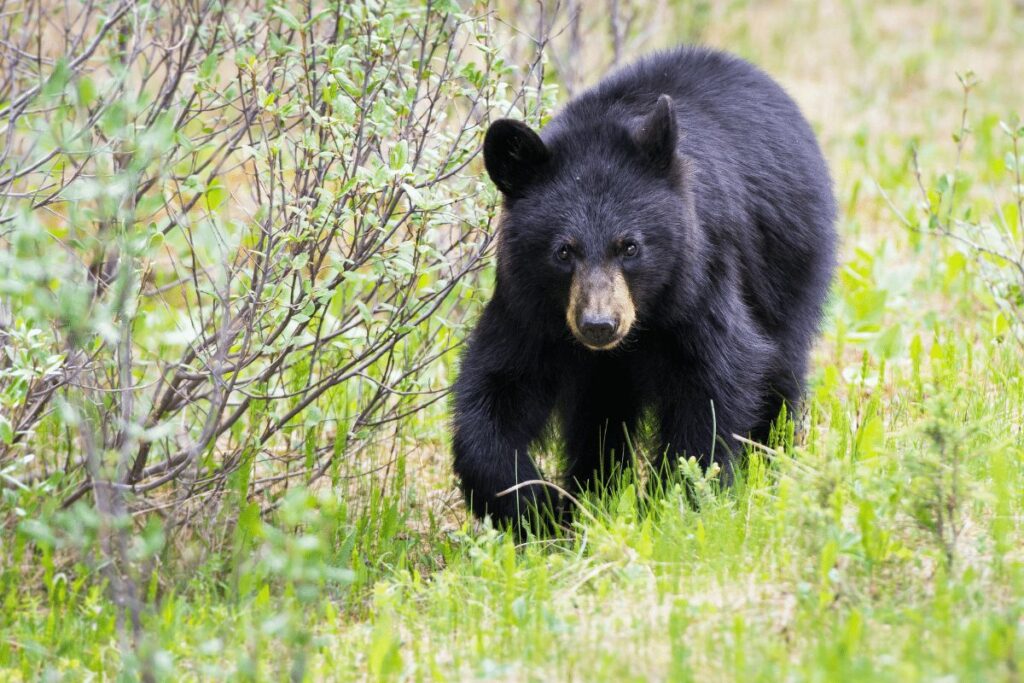
Summer brings the black bear out to wander, especially at dawn and dusk.
Hiking along the Pine Springs and Tejas Trail might just reward you with a sighting.
They’re speedy creatures, running up to 35 mph, and their coat isn’t always black; it can be brown or even cinnamon.
Gray foxes
Gray foxes are one of the many animals you may encounter while hiking in Guadalupe Mountains National Park.
These small to medium-sized canids are easily distinguished from other foxes by their gray fur, which is darker on the back and lighter on the belly.
They also have a black stripe down their back and black markings on their legs and face.
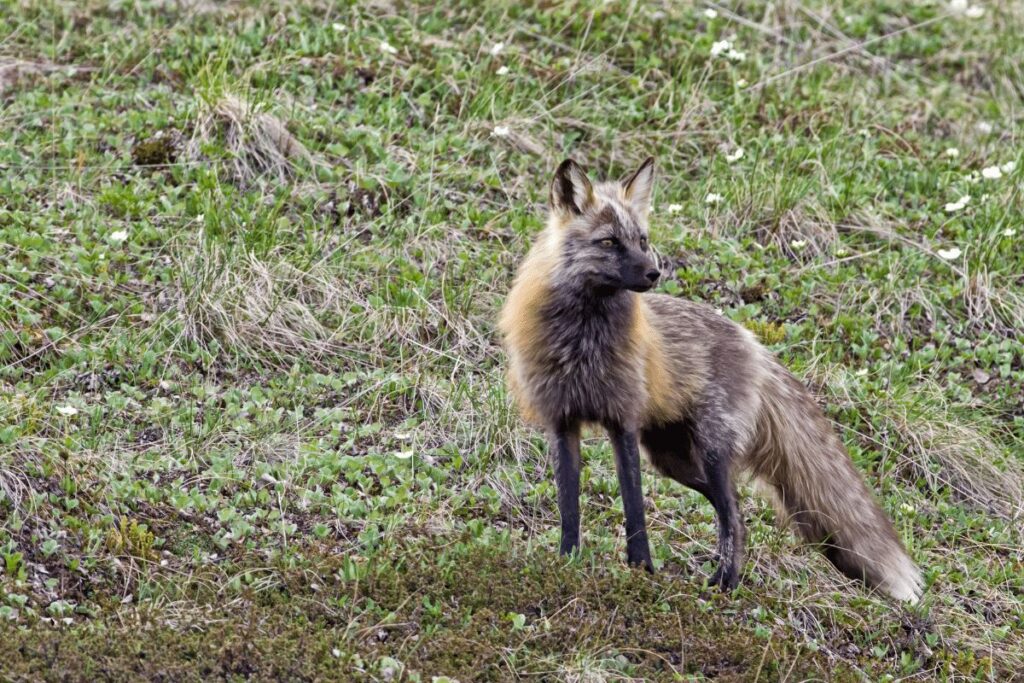
The twilight hours along the Devil’s Hall and Guadalupe Peak Trails might lead you to the elusive gray fox.
These unique canids are not only adept swimmers but can also retract their claws, much like a cat.
Plus, their bonding habits are heartwarming; they often form lifelong pairs.
Striped and hog-nosed skunks
There are two types of skunks in Guadalupe Mountains National Park: the striped skunk and the hog-nosed skunk. Both are nocturnal animals, so you’re more likely to see them at night.
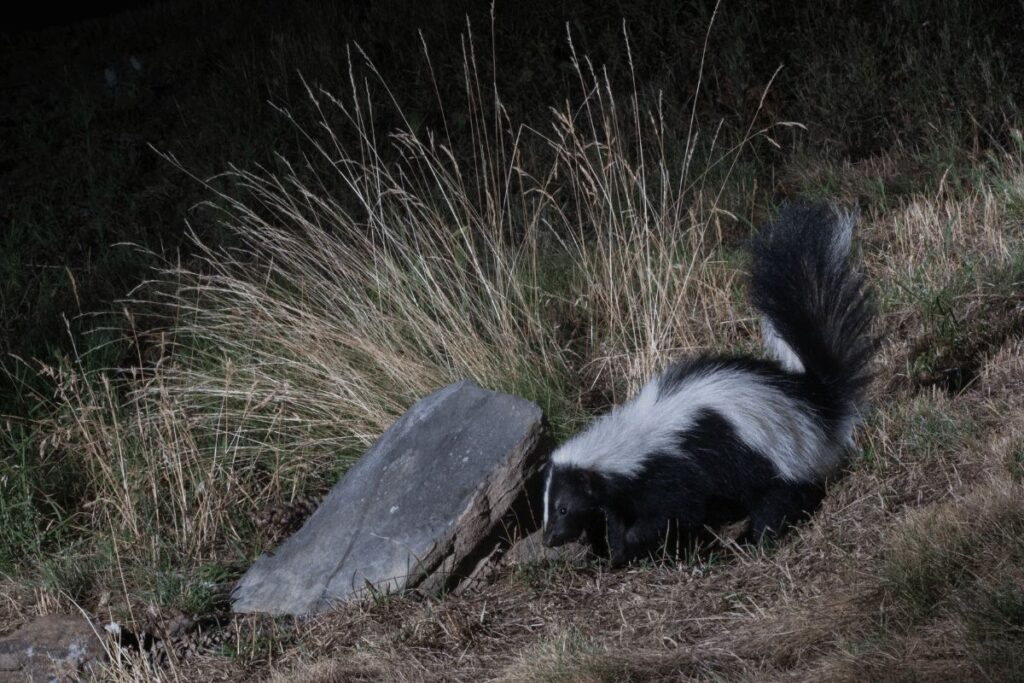
The striped skunk is the most common type of skunk in North America. They’re black with a white stripe down their backs, and they weigh between 6 and 10 pounds. These skunks are known for their strong smell, which they use to spray predators and intruders.
Hog-nosed skunks are slightly larger than striped skunks, weighing up to 15 pounds.
They have the same black and white coloration, but their stripes are wider and they have a broader noses.
These skunks don’t spray as often as striped skunks, but when they do, the smell is even stronger!
The playful stripes of these skunks can be spotted on nighttime jaunts along the Lost Peak and Frijole Trails.
While their spray is notorious, it’s also fascinating that they can emit it up to 10 feet! And for a quirky fact: the hog-nosed skunks have an entirely white back and tail.
Porcupines
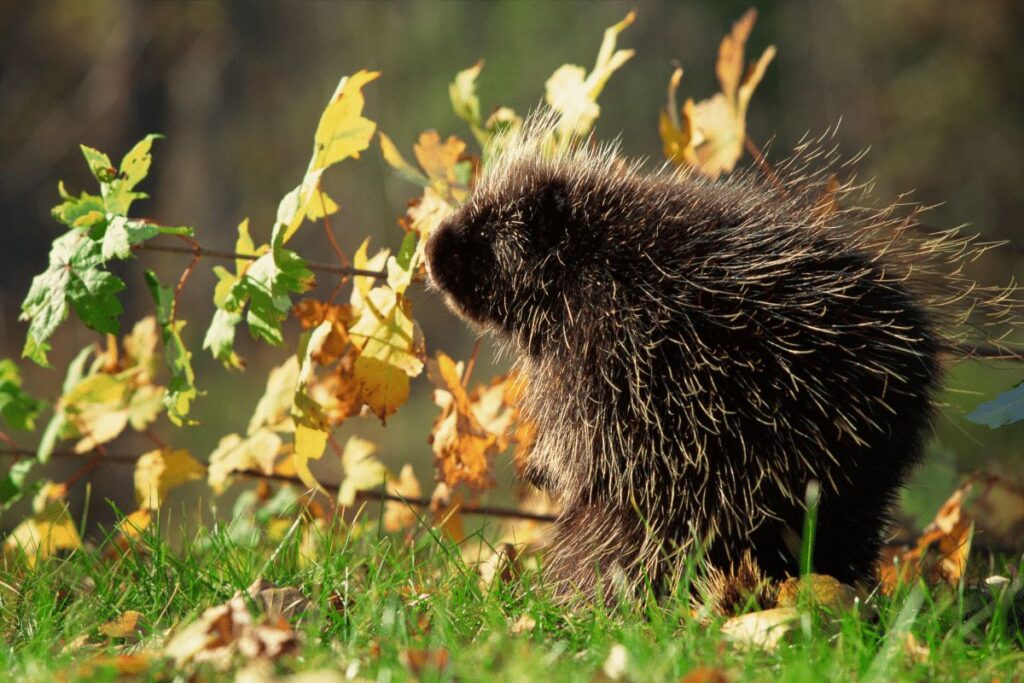
Porcupines are one of the most interesting animals in Guadalupe Mountains National Park. They are often seen while hiking, and their quills can be a hazard if you’re not careful!
Here are some things to know about porcupines in the park:
-Porcupines are nocturnal animals, so they are most active at night.
-They are proficient climbers, and can often be seen in trees.
-Porcupines have a diet that consists mostly of plants and bark.
-Their quills are actually modified hairs that are very sharp. Porcupines use their quills as a defense mechanism, and they can detach from the body if they feel threatened.
As dusk settles over the Guadalupe Mountains, porcupines begin their slow wanderings, especially around the Bush Mountain and Blue Ridge Trails. Contrary to myth, they can’t shoot their quills.
But with around 30,000 of them, they’re a sight to behold, especially when found munching on tree bark up in the branches.
Mule deer
Mule deer are a common sight in Guadalupe Mountains National Park.
The large, mule-like ears of this deer make them easy to spot during early mornings or late evenings, particularly on the Dog Canyon and McKittrick Canyon Trails.
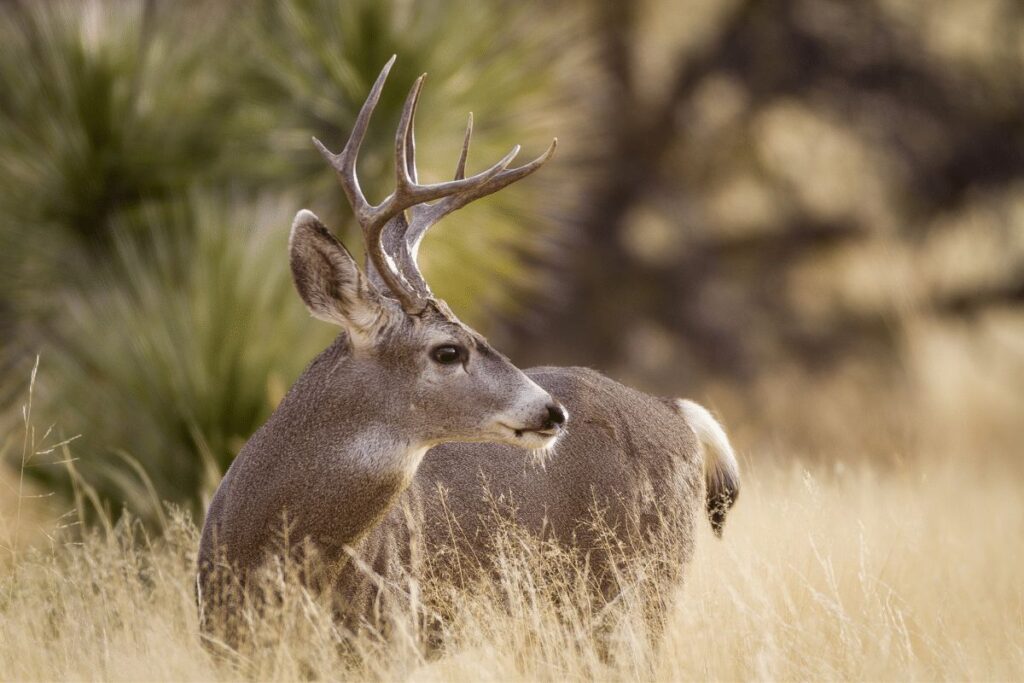
When hiking, keep your distance and watch for signs that deer may be nearby, such as tracks or droppings along the trail. If you do encounter a mule deer, remain still and quiet until it moves away. It is essential to respect their space and not disturb them in any way.
Mountain Lions (very rare)
Mountain lions are very rare in the Guadalupe Mountains National Park. However, there have been a few sightings of them in the park. If you do see a mountain lion while hiking, do not approach it. Instead, make yourself appear as large as possible and make loud noises.
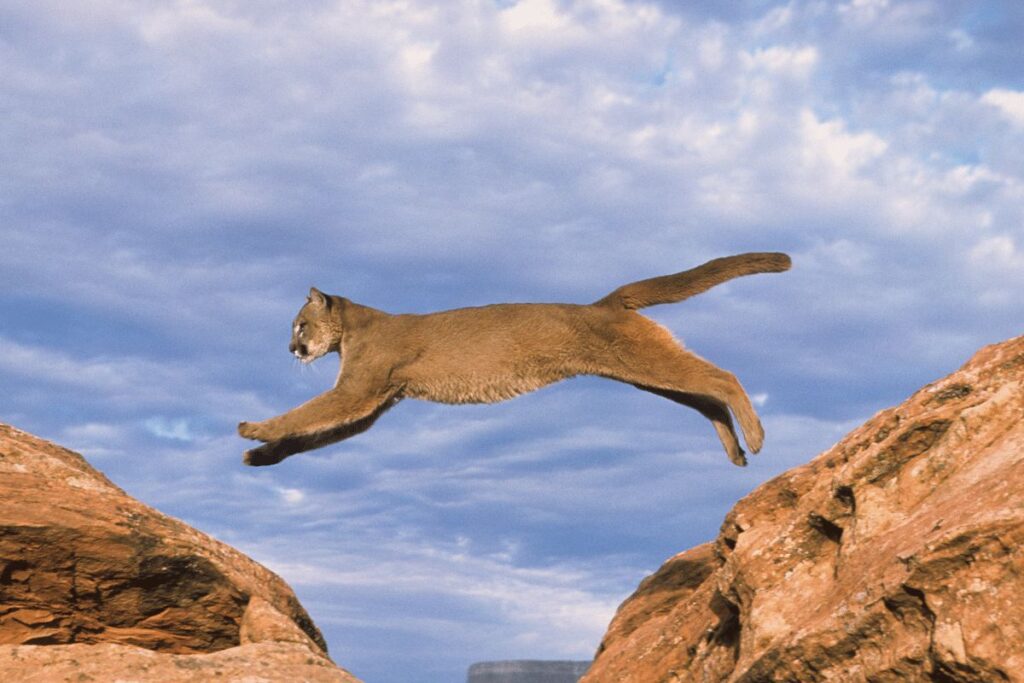
Early mornings or late evenings, especially near rocky outcroppings, are your best bet.
These powerful creatures can leap up to 40 feet in a single bound. They truly are the phantoms of the mountains.
They are beautiful animals, but it is important to remember that they are wild and should be respected from a distance.
Javelinas
If you’re hiking in Guadalupe Mountains National Park, be on the lookout for javelinas!
These furry creatures are actually members of the pig family, and they’re common in the park. We saw several while we were hiking and they were definitely one of the highlights of our trip!
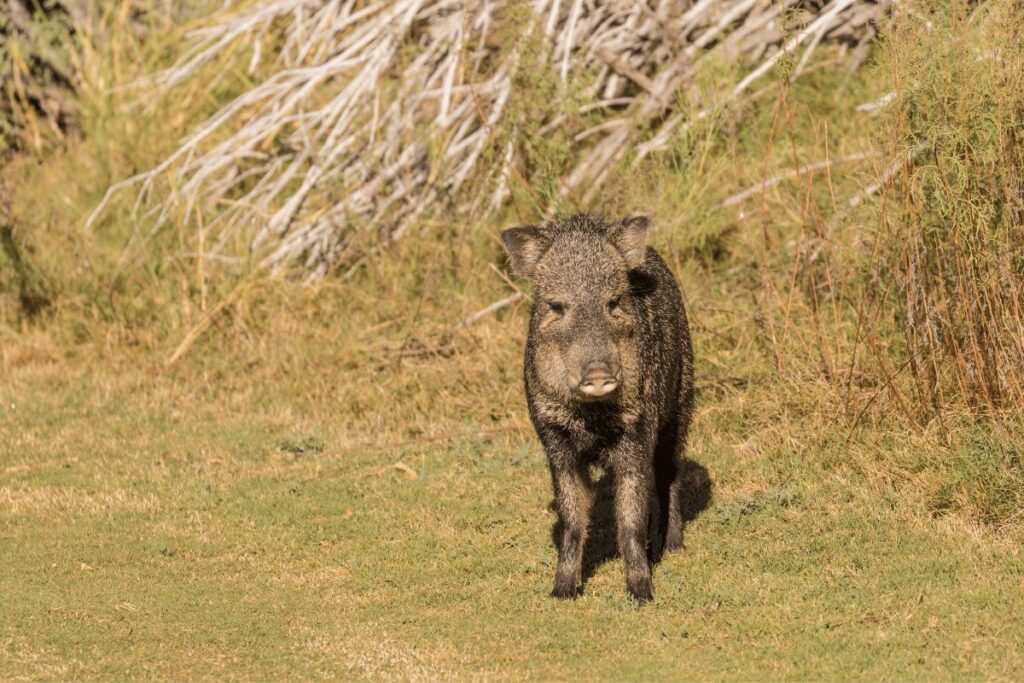
Since javelinas are wild animals, it’s important to remember to give them plenty of space and not approach them or try to feed them. It’s also a good idea to be aware of your surroundings and watch for signs that javelinas may be nearby, such as tracks or scat.
Often mistaken for pigs, javelinas can be seen foraging during the early morning or late evening, especially near the Marcus Overlook and Manzanita Spring Trail. They have a keen sense of smell and sport sharp tusks, a reminder to admire from a distance.
Badgers
If you’re hiking in the Guadalupe Mountains National Park, you would be luck to see a badger! They are rare and elusive but very interesting creatures.
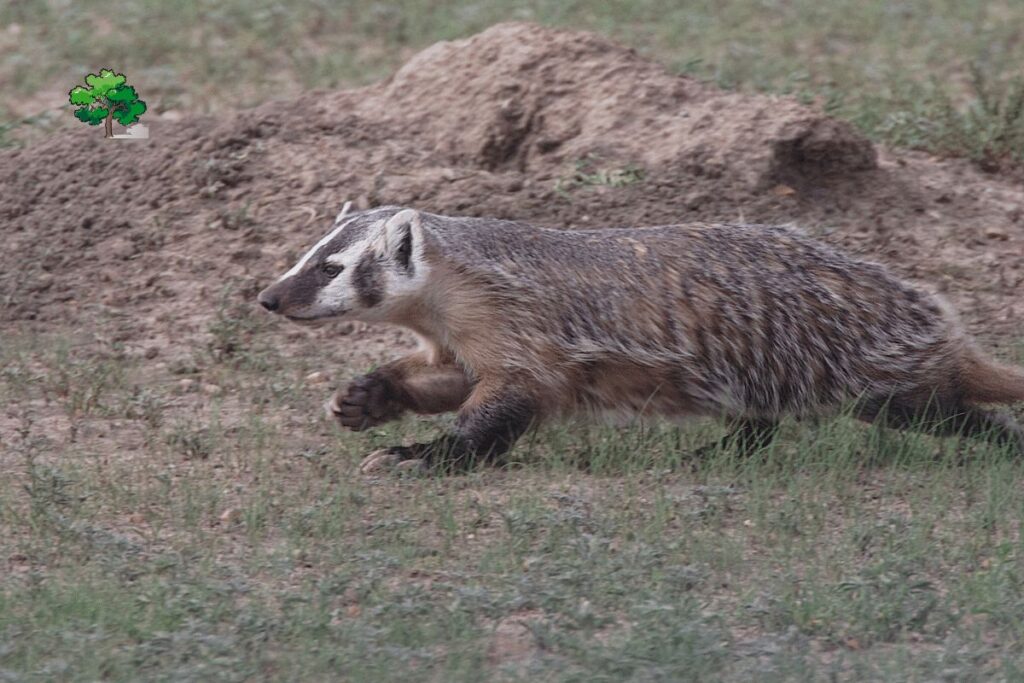
Badgers are small mammals with short legs and long bodies.
They have thick fur that is usually brown or black and a white stripe running down their backs.
Badgers are very shy animals, but they will approach humans if they think they might have food.
If you’re hiking along the Bear Canyon or El Capitan Trail at night, you might spot the fierce and swift badger.
Known for their digging prowess, they have a penchant for earthworms, sometimes eating hundreds in one night!
Mountain short-horned lizards
Mountain short-horned lizards are one of the many animals that you might see while hiking in Guadalupe Mountains National Park.
These lizards are small, with adults reaching a maximum length of about 4 inches.
They are brown or gray in color, with dark stripes running down their backs.
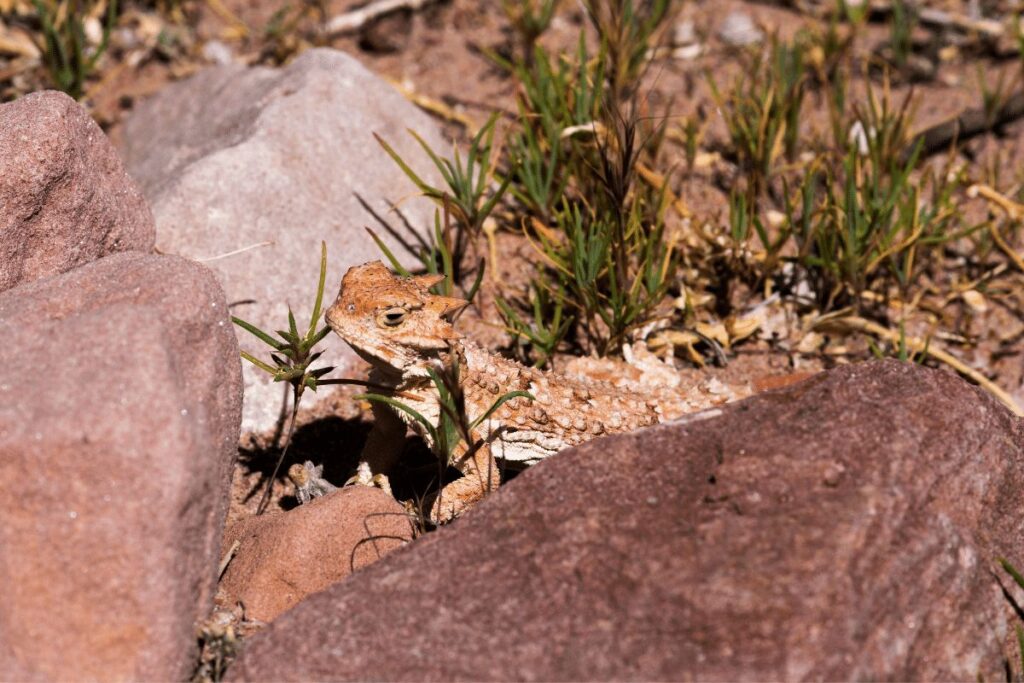
Mountain short-horned lizards are found in rocky areas and can often be seen basking in the sun on rocks or logs. If you’re lucky enough to see one of these lizards while hiking, be sure to give it plenty of space and don’t disturb its habitat.
Sunny days on the Salt Basin Overlook or Permian Reef Trail may introduce you to these fascinating reptiles.
Their diet is ant-heavy, but it’s their defense mechanism that’s truly astonishing: when threatened, they squirt blood from their eyes!
Birds in Guadalupe Seen On Our Hikes
Our hikes in Guadalupe Mountains National Park were more than just a breathtaking experience of the diverse landscapes; they were an immersion into a vibrant world of avian wonders. Everywhere we went, the air was filled with melodious bird calls, and the skies showcased the beauty and grace of winged creatures.
The Golden Eagle was one of our most majestic sightings. Soaring high over the rugged peaks, its powerful wings cut the air with precision, casting a large shadow on the ground below. Another spectacle was the delicate Lucifer Hummingbird, darting between flowers with its iridescent plumage catching the sunlight.
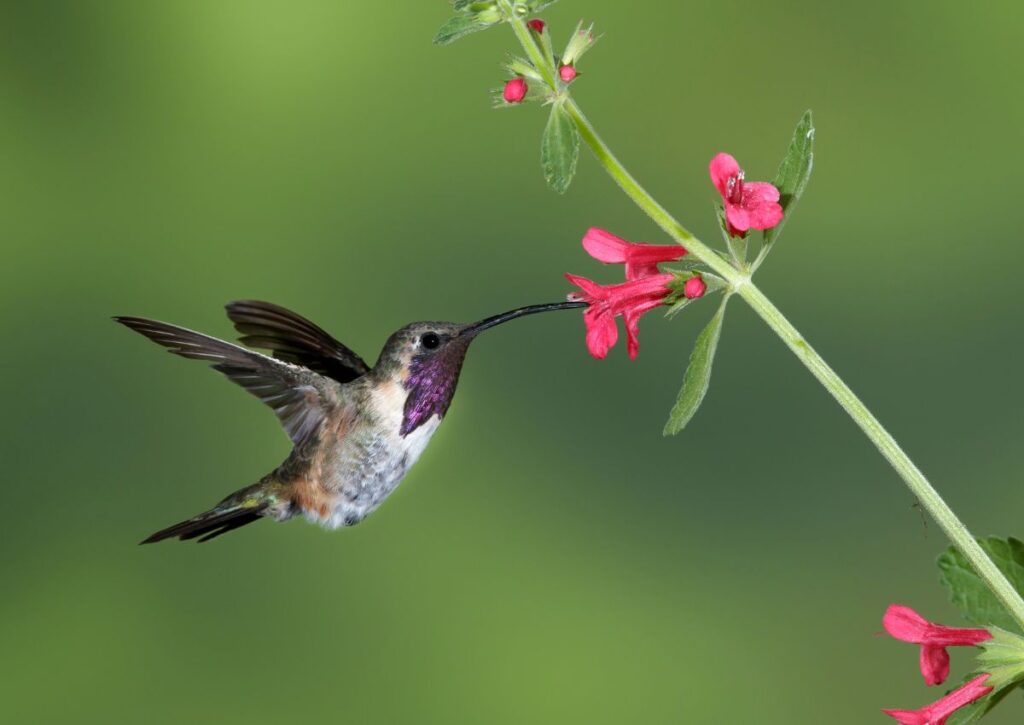
This tiny bird, with its agility and grace, often left us in awe. The shrubs and lower vegetation often played host to the Black-throated Sparrow, whose melodious songs added rhythm to our hikes.
We were fortunate to spot the Mountain Bluebird and the vibrant Scott’s Oriole on several occasions. Their brilliant hues added color to the vast expanse of the park. The iconic Scott’s Oriole, in particular, was often seen in the pine and oak woodlands, its striking black and yellow plumage contrasting beautifully with the green backdrop.
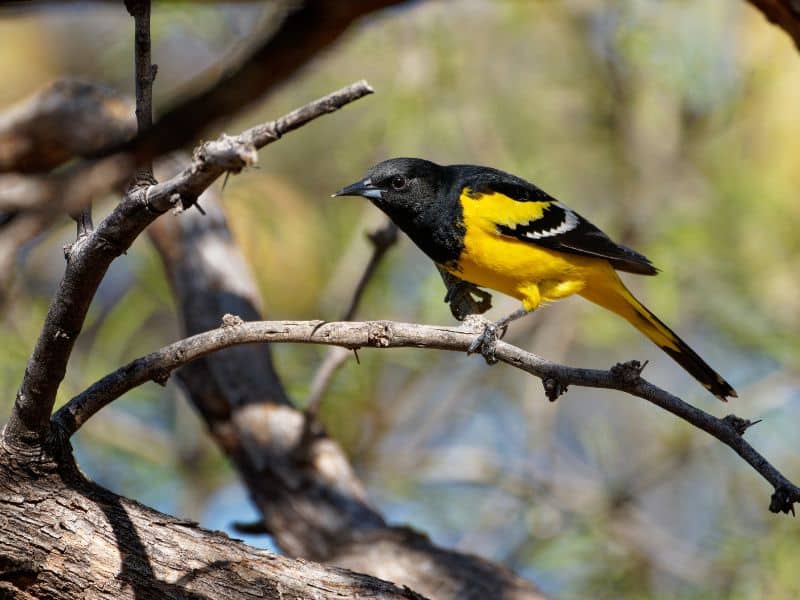
However, it wasn’t just about the commonly seen birds. On one of our treks through McKittrick Canyon, we chanced upon a Zone-tailed Hawk, circling the sky in search of prey. This rare bird, with its distinctive markings, was truly a prize sighting for us.
Of all the places, Smith Spring and Pine Springs Campground were the most rewarding in terms of birdwatching. These areas, with their diverse habitats, attracted a multitude of species, allowing for a richer birding experience.
The trails of Guadalupe Mountains National Park provided us not only with scenic beauty but also a closer look at some of the most exquisite bird species. Whether you’re an avid birder or just a nature lover, the park promises a visual and auditory treat that lingers in your memories long after the hike is over.
Hiking trails to see animlas in Guadalupe Mountains National Park
The Guadalupe Mountains offer plenty of amazing hiking trails for visitors to explore. We saw plenty of animals while we were out on the trails, including deer, lizards, snakes, and birds. The views from the trails are incredible, and we even got to see some of the park’s famous rock formations up close.

Guadalupe Peak Trail, an 8.2-mile loop, stands as the park’s crowning glory. As we climbed its challenging gradient, the reward was twofold: panoramic vistas of the sprawling desert and intimate encounters with deer, who seemed just as captivated by the beauty around them.
Birds, flying above, accompanied our ascent, their calls echoing the wild spirit of the place.
Descending into the park’s heart, we traversed the McKittrick Canyon Trail. Spanning 7.5 miles, this path felt like a voyage through time.
The ancient rock formations whispered tales of epochs gone by, while vibrant lizards dashed across our path and elusive snakes hinted at the mysteries hidden beneath the rocks.
The Pine Springs Canyon Trail, at 4.3 miles, offered a blend of nature’s artistry. Iconic rock formations reached skyward, painting a majestic picture, while the melodious songs of diverse birds filled the air, each species serenading us with its own unique tune.
Venturing further, the 5-mile Tejas Trail unfolded before us like a storybook. The landscapes shifted and danced, revealing cautious lizards and hinting at the presence of snakes in the undergrowth, a reminder of nature’s unpredictability.
A gentle respite awaited us on the Smith Spring Loop, a shorter 2.8-mile trail. As we circled the refreshing spring, the air seemed alive with birdcalls, each note resonating with the spirit of the wilderness.
The vast expanse of the El Capitan Trail beckoned. Over its 6.6 miles, the desert stretched endlessly, giving us a vantage point to admire its vastness.
Here, amidst the sweeping views, we glimpsed the subtle beauty of the Guadalupe: the scurrying of lizards, the distant shapes of wildlife, and the profound silence of the desert.
In the Guadalupe Mountains, every trail is more than just a path; it’s an invitation to engage with the wild, to listen to its stories, and to be transformed by its profound beauty.
Best Time to See Wildlife in Guadalupe Mountains National Park
Guadalupe Mountains National Park is a haven for wildlife enthusiasts. If you’re hoping to catch a glimpse of the park’s diverse inhabitants, choosing the right time to visit is crucial.
Spring (March to May): As winter fades, the park becomes more vibrant. The cooler mornings and late afternoons of spring are ideal for birdwatching, as many species migrate through.
Lizards start becoming more visible, basking on sun-drenched rocks, and mule deer are often spotted grazing amidst the budding vegetation.
Summer (June to August): The desert’s midday heat is potent, but the early mornings and twilight hours are fruitful for wildlife observation. Creatures like black bears and gray foxes might be seen searching for food.
Nightfall brings out animals such as the hog-nosed skunk. Reptile enthusiasts will find summer especially rewarding, as snakes are quite active.
Fall (September to November): The cooler atmosphere of fall brings about another shift in animal behavior. The echoing calls of elk, particularly during the rutting season, can be a highlight.
Animals like javelinas increase their foraging activity, preparing for the upcoming winter months.
Winter (December to February): The park’s chillier days offer unique opportunities. The tracks of elusive creatures like mountain lions might be spotted in the snow, hinting at their presence.
Additionally, the clear winter skies make it a great time to observe birds of prey, including hawks and eagles.
While these periods suggest optimal times, it’s worth noting that nature is unpredictable. Every trip to Guadalupe Mountains National Park holds the promise of unexpected wildlife encounters.
Conclusion
Guadalupe Mountains National Park is a stunning and diverse landscape, home to an incredible array of wildlife. We hope this article has inspired you to explore the park for yourself, and given you some ideas on what animals to look out for.
There’s nothing quite like standing in the great outdoors and being able to observe nature up close; so why not take a trip down to Guadalupe Mountains National Park today?


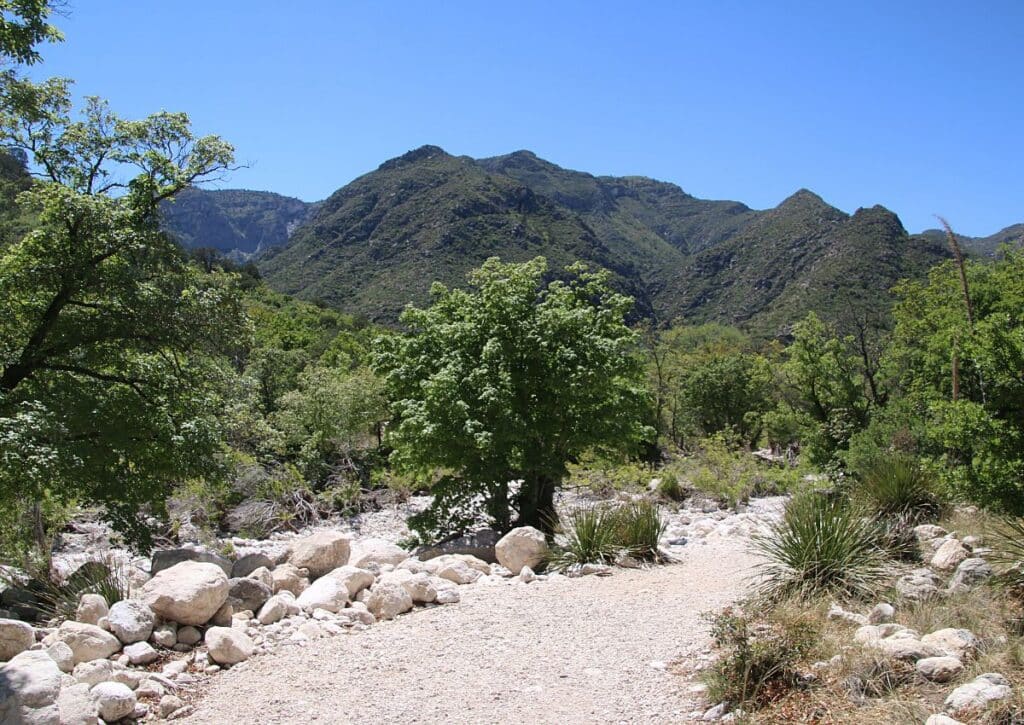
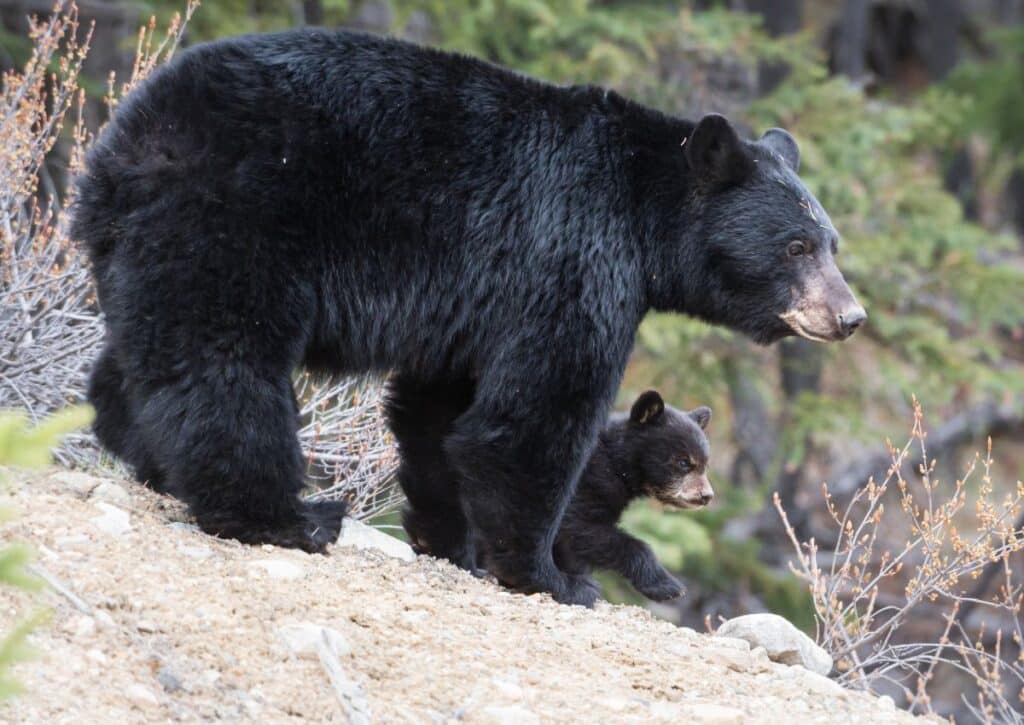
The badger shown in the photo here is a European badger noce try. They are not common at all and elusive by nature.
Hey Rex,
thanks for pointing that out! Our Apologies.
It was an editing error which is corrected. You are right, that was a photo from Europe which will come out in a blog later this month 🙂
thanks for keeping us on our toes!!
AK
Beautiful park that doesn’t get many visitors. In September 2023 I climbed Guadalupe Peak and saw several mule deer near the visitor center. On the trail I observed collared lizards and a tarantula spider closer to the top of the peak. What a great surprise that was! There were many birds and other lizards around but they were too quick for a picture. The variety of plant life is interesting also. I hope to get back there and explore other areas and see more wildlife. Thanks for the article.